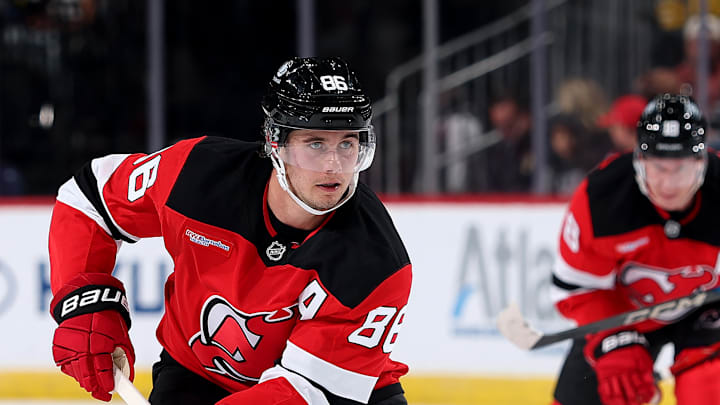The New Jersey Devils are off to a strong start at 3-1-0, and early indicators show the franchise’s patient rebuilding strategy is beginning to pay dividends. Preseason projections had the team at 45 wins and 105 points, and the strong start to this season suggests those numbers are achievable. Beyond wins and points, however, the real story is how the young core is stepping into roles that carry responsibility and expectation, and how this aligns perfectly with the team’s cap strategy and long-term planning.
Offensively, the Devils’ core is playing with an assertiveness that's pushing them forward. Dawson Mercer, Timo Meier, Jack Hughes, and Nico Hischier have all scored, demonstrating both skill and situational awareness. Mercer’s net front aggression and forechecking, Meier’s scoring touch, Hughes’ playmaking, and Hischier’s two-way poise create a multi-dimensional attack. Luke Glendening adds timely scoring and veteran stability, giving the young forwards the freedom to play assertively without sacrificing structure.
Depth scoring is emerging as well. Arseny Gritsyuk has three assists in four games, stepping up while Evgenii Dadanov recovers. His early production is more than a short-term stopgap. It signals the organization’s depth and the ability of young, lower-cost players to make meaningful contributions. From a cap perspective, having players like Gritsyuk able to step into scoring roles is a clear advantage, allowing flexibility for future trades or re-signings without compromising roster performance.
Defensively, the team shows significant growth. Simon Nemec demonstrated his defensive prowess during the big win versus Florida, while Luke Hughes is displaying increased confidence alongside Dougie Hamilton. Coach Brad Shaw has installed a strong, supportive two-way system that demands accountability from all defenders and forwards. This approach allows young defensemen to develop in high-leverage minutes while maintaining team stability. From a cap standpoint, developing top-pairing talent internally, such as Nemec and Hughes, reduces reliance on expensive free-agent contracts, preserving flexibility for key moves around the deadline or in future offseasons.
The convergence of a dynamic offense and developing defense explains why this timing is ideal. Historically, prospects needed patience, often waiting behind veterans for meaningful minutes. Now, strategic offseason acquisitions such as Brett Pesce and Brenden Dillon, combined with the maturation of the young roster, create the perfect environment. Mercer, Meier, Hughes, Hischier, Glendening, Gritsyuk, Nemec, and Luke Hughes are all contributing in high-leverage situations both offensively and defensively. Their integration not only strengthens the team on the ice but also positions the Devils well for asset management, trading flexibility, and long-term roster planning.
Finally, goaltending reflects the same strategic philosophy. Nico Daws is seeing roughly 30 percent of the team’s starts, easing the workload on Jacob Markstrom and Jake Allen. Translating last season’s pace into this role projects 12 to 13 wins, providing a reliable safety net and giving the skaters confidence that the net is secure. From a cap perspective a developing, manageable cost goalie like Daws allows the Devils to balance veteran salaries with younger, cost controlled talent freeing up flexibility for midseason moves or future roster upgrades. If there is a tandem of forwards that is really good, it’s the Connor Brown-Arseny Gritsyuk combo that drives the net but also has surgical chemistry that is hard to beat.
In short, the Devils are executing a calculated plan on multiple fronts. Contributions from Mercer, Meier, Hughes, Hischier, Glendening, and Gritsyuk, paired with Nemec and Luke Hughes’ defensive growth under Hamilton and Shaw, plus Daws’ measured presence in net, demonstrate a roster increasingly defined by young players assuming responsibility. From both performance and cap strategy perspectives, this is precisely how the Devils envisioned bridging competitive success with sustainable growth.
The 2025 26 Devils are not just chasing points; they are building an identity. Young players are emerging as the new young veterans, making meaningful contributions at both ends of the ice while preserving cap flexibility and future trade leverage. With a strong start, smart workload management, and a system that emphasizes two-way accountability, the Devils are positioned not only to meet preseason projections but potentially exceed them. The timing could not be more perfect.
